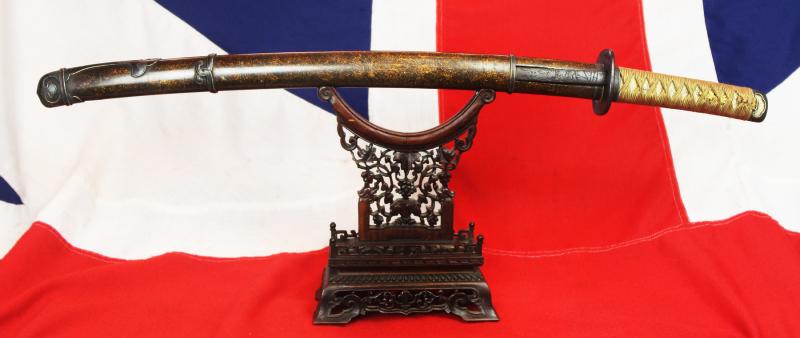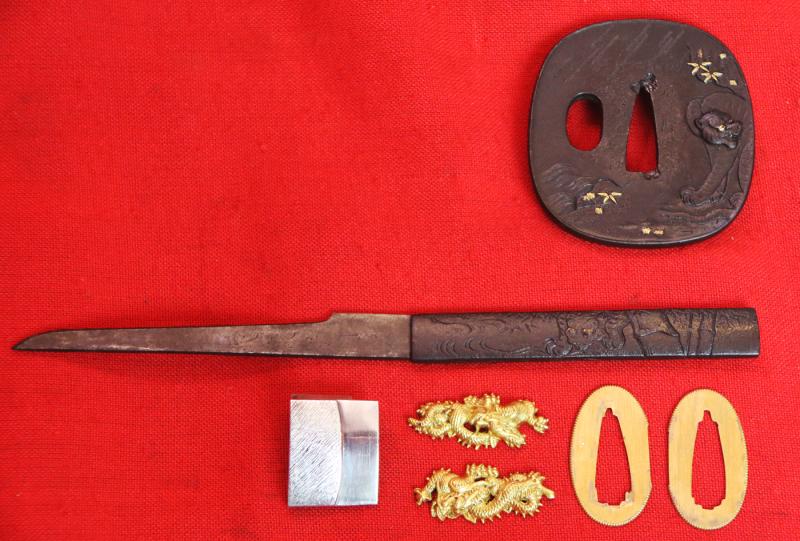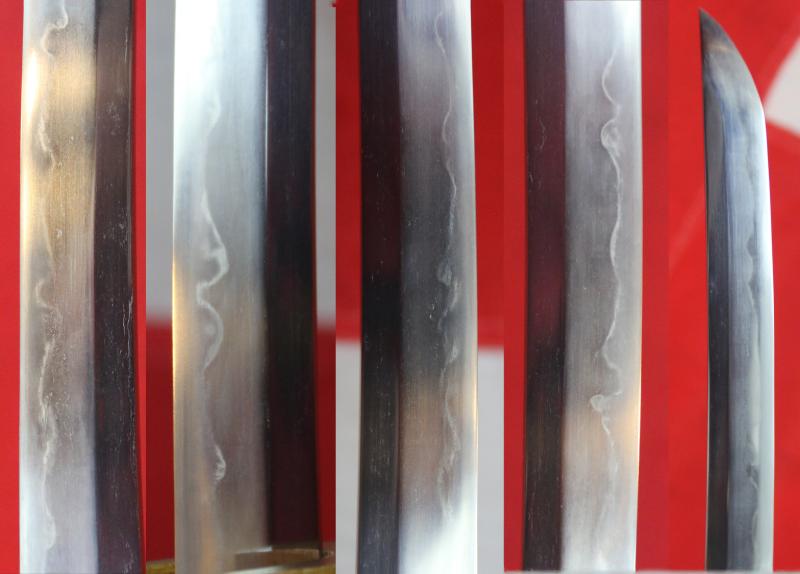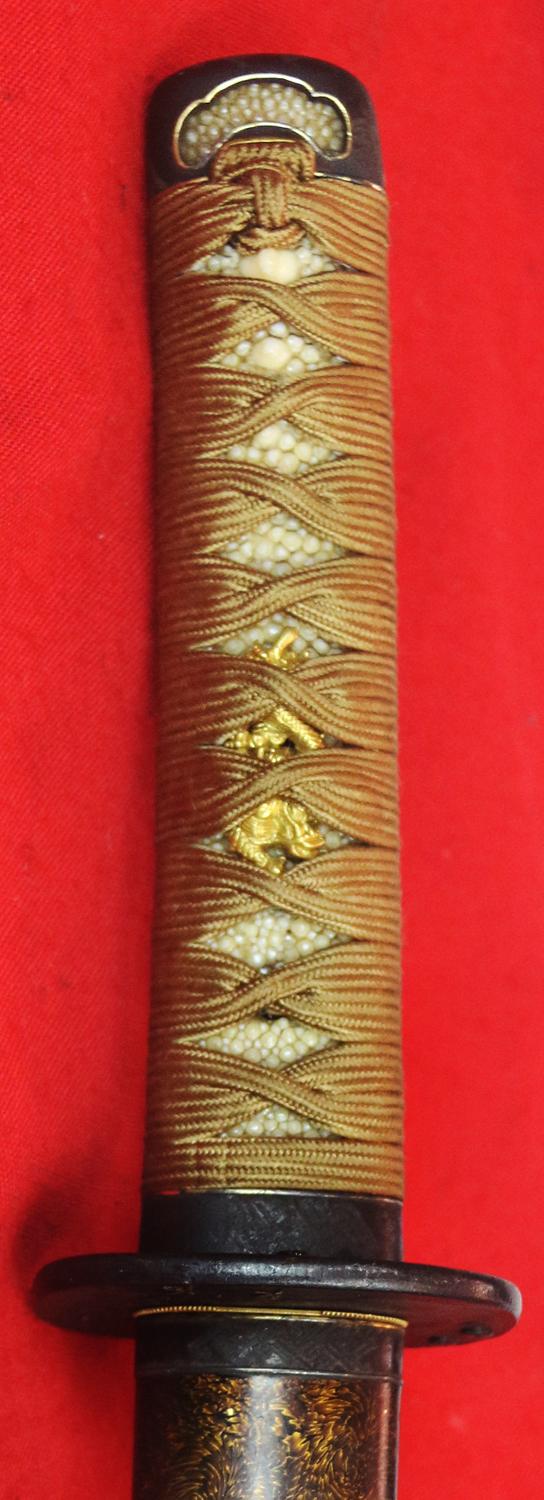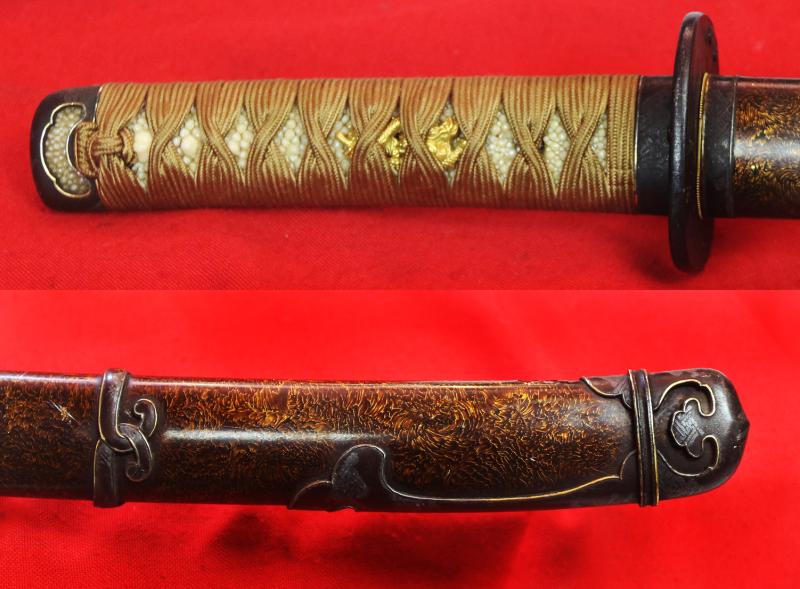A Stunning Quality Wakizashi Signed with Honorific Title Masatoshi, Lord of Etchu, Han Dachi Mounted, Gold Dragon Menuki, Mishina School Blade, Early 1600's, Wonderful Signed Tsuba and Matching Kozuka Depicting the Tiger in the Bamboo Grove
We now are delighted to show it with its fully rebound tsuka in gold silk. The tsuka has been rebound traditionally, in finest gold tsukaito by our medal winning Japanese koshirae artisan, and it looks amazing.
Mishina School, Etchu (no) Kami Masatoshi. The stunning blade shows a beautiful and complex hamon in super polish. All original Edo mounts, superb signed *tsuba and kozuka all decorated with the legendary ‘Tiger in the Bamboo Grove’ theme. The kozuka is signed, as is its kogatana blade
* Tsuba signed Taizan Mototaka of Mito/Hitachi. Mototaka, was the founder of the Sekijoken line, was a son of Taizan-Motonori, a pupil of the Yokoya school, who signed his work Sekijoken-Taizan-Mototaka. He worked during the last part of the eighteenth century and lived to a great age. He was most skillful in the style of the Nara artists, Joi, Shozui, Yasuchika, Toshinaga, etc., and a teacher of great ability, his most expert pupil was Takase-Yeiju (or Hisan- aga), who worked during the late eighteenth and early nineteenth centuries.
The artists of the Sekijoken school at first followed the style of Yokoya, but later they turned to the Nara school. Tigers were considered the strongest animals. They were often shown with bamboo to symbolize the hospitality of the weak for the strong. In Chinese art, the tiger was traditionally related to the four directions as the animal
of the West, and was often paired with the dragon, which represented the East. Kano artists frequently depicted tigers with holy men, abbots, or monks, reflecting their mystic presence and association with Zen Buddhism. A tiger is said to be the only animal capable of navigating through thick bamboo forests, and the pairing of the two symbols is said to represent a harmonious and peaceful society. The bamboo alone stands for resilience and integrity, admired virtues of noble men.
Incredible quality pure gold overlay dragon menuki, gold overlaid seppa. Fully matching suite of handachi iron fittings trimmed in gold with patterning silver overlay. The original Edo saya has superb antique *urushi lacquer with pure gold, under clear lacquer, called Byakudan nuri: Transparent lacquer of a golden yellow colour, beautifully decorated with amazingly intricate billowing flaming-feather like swirls
Kyo Go Kaji 京五鍜冶 is short for Kyoto Go Kaji 京都五鍜冶 which means five swordsmiths of Kyoto. The term was developed to describe a group of related smiths who worked prosperously in the Kyoto area during shinto times. They made good quality works with similar characteristics and each had many students for generations. They are Iga (no) Kami Kinmichi 伊賀守金道, Echigo (no) Kami Kinmichi 越後守金道, Tanba (no) Kami Yoshimichi 丹波守吉道, Etchu (no) Kami Masatoshi 越中守正俊 and Omi (no) Kami Hisamichi 近江守久道. These smiths all had Mishina 三品 as their last name. The first four were sons of Seki Kanemichi 兼道 and Hisamichi was a student of Kanemichi's grandson.
* Japanese lacquer, or urushi, is a transformative and highly prized material that has been refined for over 7000 years.
Cherished for its infinite versatility, urushi is a distinctive art form that has spread across all facets of Japanese culture from the tea ceremony to the saya scabbards of samurai swords
Japanese artists created their own style and perfected the art of decorated lacquerware during the 8th century. Japanese lacquer skills reached its peak as early as the twelfth century, at the end of the Heian period (794-1185). This skill was passed on from father to son and from master to apprentice.
Some provinces of Japan were famous for their contribution to this art: the province of Edo (later Tokyo), for example, produced the most beautiful lacquered pieces from the 17th to the 18th centuries. Lords and shoguns privately employed lacquerers to produce ceremonial and decorative objects for their homes and palaces.
The varnish used in Japanese lacquer is made from the sap of the urushi tree, also known as the lacquer tree or the Japanese varnish tree (Rhus vernacifera), which mainly grows in Japan and China, as well as Southeast Asia. Japanese lacquer, 漆 urushi, is made from the sap of the lacquer tree. The tree must be tapped carefully, as in its raw form the liquid is poisonous to the touch, and even breathing in the fumes can be dangerous. But people in Japan have been working with this material for many millennia, so there has been time to refine the technique!
Flowing from incisions made in the bark, the sap, or raw lacquer is a viscous greyish-white juice. The harvesting of the resin can only be done in very small quantities.
Three to five years after being harvested, the resin is treated to make an extremely resistant, honey-textured lacquer. After filtering, homogenization and dehydration, the sap becomes transparent and can be tinted in black, red, yellow, green or brown.
Once applied on an object, lacquer is dried under very precise conditions: a temperature between 25 and 30°C and a humidity level between 75 and 80%. Its harvesting and highly technical processing make urushi an expensive raw material applied in exceptionally fine successive layers, on objects such as bowls or boxes.After heating and filtering, urushi can be applied directly to a solid, usually wooden, base. Pure urushi dries into a transparent film, while the more familiar black and red colours are created by adding minerals to the material. Each layer is left to dry and polished before the next layer is added. This process can be very time-consuming and labour-intensive, which contributes to the desirability, and high costs, of traditionally made lacquer goods. The skills and techniques of Japanese lacquer have been passed down through the generations for many centuries. For four hundred years, the master artisans of Zohiko’s Kyoto workshop have provided refined lacquer articles for the imperial household
In photos 3 & 5 in the gallery we show the stunning pair of pure gold layered dragon menuki before they were mounted on the samegawa and then bound under the gold tsuka-ito.
* Notes from the Special exhibition
( 1907-1908 ) of Japanese sword guards, tsuba,
has been prepared by Mr. Okabe-Kakuya.
Code: 25337
7450.00 GBP


